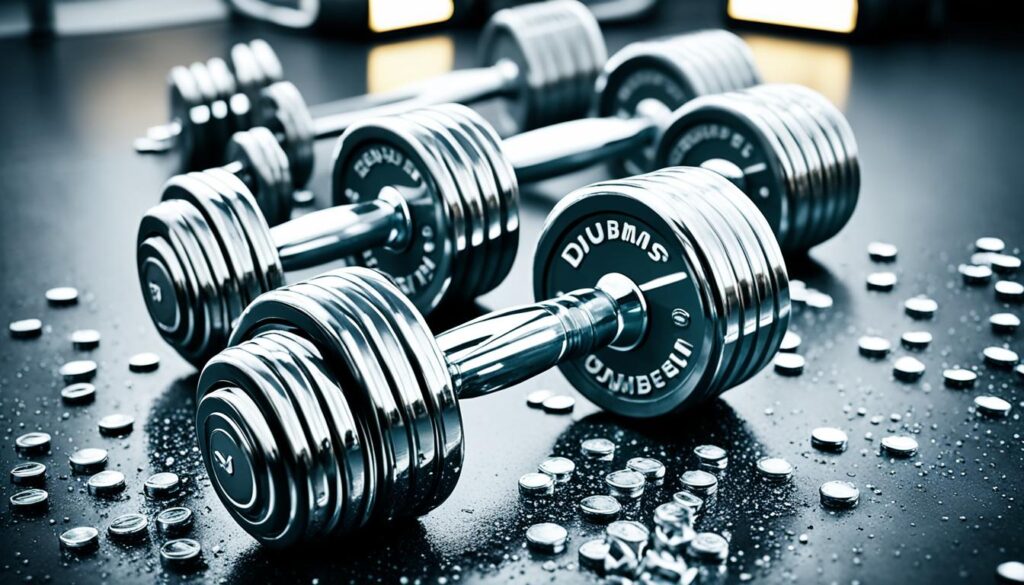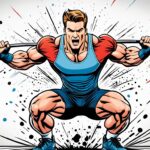Optimizing olympic weightlifting
Did you know that Olympic weightlifting can offer remarkable benefits beyond building muscle? In fact, it’s a sport that demands a unique combination of technique, strength, and a strategic approach to dumbbell and gym routines. Whether you are a seasoned lifter or just starting out, optimizing your performance in Olympic weightlifting can take your training to new heights.
In this comprehensive guide, I will share valuable insights and expert tips to help you excel in Olympic weightlifting. From mastering the precise techniques to boosting your overall strength, this article will equip you with the knowledge and tools necessary to reach your full potential.
Key Takeaways:
- Mastering proper technique is crucial for Olympic weightlifting success.
- Building strength is essential for maximizing your performance.
- Integrating dumbbells and gym routines can enhance your training regimen.
- Consistency and dedication are key to unlocking your Olympic weightlifting potential.
- Follow the expert advice and tips provided to optimize your workouts and achieve your lifting goals.
Mastering Technique in Olympic Weightlifting
Developing proper technique is crucial in Olympic weightlifting. The correct execution of each lift, such as the snatch and clean and jerk, is essential to maximize your performance and prevent injuries. In this section, I will guide you through the fundamental elements of these lifts and provide valuable tips and exercises to help you perfect your form.
Let’s start with the snatch, which is a complex movement that requires precision and coordination. Proper technique involves explosive power, speed, and flexibility. By focusing on the following key points, you can improve your snatch technique:
- Starting Position: Begin with your feet shoulder-width apart, gripping the barbell with a wide overhead grip. Maintain a rigid back and ensure your shoulders are slightly in front of the bar.
- First Pull: Initiate the lift by extending your legs, keeping your back angle consistent. The barbell should move close to your body as you lift.
- Second Pull: As the barbell reaches mid-thigh, rapidly extend your hips, shrug your shoulders, and pull the barbell vertically with the momentum generated from your explosive hip extension.
- Catch: To receive the barbell, quickly drop into a deep overhead squat position with your elbows locked out. Ensure your feet land in a stable position.
- Recovery: Stand up with the barbell overhead, maintaining control and balance. Fully extend your hips and knees.
Next, let’s focus on the clean and jerk, which combines strength and power. Here are some essential tips to refine your clean and jerk technique:
- Starting Position: Similar to the snatch, begin with your feet shoulder-width apart and grip the barbell with a slightly wider than shoulder-width grip. Keep your back straight and shoulders slightly in front of the bar.
- Clean: Initiate the clean by extending your legs and fully extending your hips. As the barbell reaches mid-thigh, explosively pull the barbell vertically while simultaneously dropping into a quarter squat position.
- Rack Position: Catch the barbell on your front shoulders with your elbows high and the barbell resting across your collarbone. Stand up with the barbell, maintaining a stable and balanced position.
- Jerk: From the rack position, quickly dip your knees and extend your hips and legs to drive the barbell overhead. Lock out your elbows and stabilize the weight overhead.
- Recovery: Stand up with the barbell overhead, ensuring complete control and balance. Fully extend your hips and knees.
Remember, mastering technique in Olympic weightlifting takes time and practice. Focus on perfecting each element of the lifts and seek guidance from qualified coaches or trainers. Now, let’s move on to the next section and explore how to boost your strength for Olympic weightlifting.
Boosting Strength for Olympic Weightlifting
Building strength is vital for Olympic weightlifters. In order to enhance your overall performance, it’s important to incorporate effective strength training exercises into your routine. In this section, we’ll explore two key exercises that can help you develop the necessary strength for Olympic weightlifting: the split squat and deadlift.
Split Squat
The split squat is a unilateral exercise that targets the muscles of the lower body, including the quadriceps, glutes, and hamstrings. It also challenges your core stability and balance. Here’s how to perform a split squat:
- Stand in a split stance with one foot positioned forward and the other foot positioned behind you.
- Lower your body by bending your knees, keeping your torso upright and your front knee in line with your front foot.
- Push through your front foot to return to the starting position.
The split squat can be modified to increase intensity by adding weights, such as dumbbells or a barbell. Performing this exercise regularly can help improve leg strength and stability, which are essential for explosive movements in Olympic weightlifting.
Deadlift
The deadlift is a compound exercise that targets multiple muscle groups, including the legs, back, and core. It’s a highly effective exercise for building overall strength and power. Here’s how to perform a deadlift:
- Stand with your feet hip-width apart, with the barbell placed in front of you on the floor.
- Bend at your hips and knees to lower your body and grip the barbell with an overhand grip.
- Keeping your back straight, push through your legs and drive your hips forward to lift the barbell off the floor.
- Lower the barbell back down to the starting position in a controlled manner.
For beginners, it’s important to focus on maintaining proper form and starting with lighter weights. As you progress, gradually increase the weight to continue challenging your muscles and building strength.
Both the split squat and deadlift are effective strength training exercises that can benefit Olympic weightlifters. By incorporating these exercises into your training routine, you’ll be able to increase your overall strength and improve your performance in the sport.
Expert Tips for Strength Training
“When performing strength training exercises for Olympic weightlifting, it’s important to focus on proper form and technique. Start with lighter weights and gradually increase the intensity as you progress. Remember to prioritize rest and recovery to allow your muscles to repair and grow stronger.”
– Jessica Smith, Olympic weightlifting coach
Optimizing your strength training routine is crucial for maximizing gains in Olympic weightlifting. Here are some expert tips to help you get the most out of your training:
- Include both compound exercises, like the split squat and deadlift, as well as isolation exercises to target specific muscle groups.
- Vary your training intensity by incorporating high-intensity interval training (HIIT) sessions and strength-building sets and reps.
- Allow for adequate rest and recovery between training sessions to prevent overtraining and reduce the risk of injury.
- Consider working with a qualified strength and conditioning coach who can design a personalized training program tailored to your specific needs and goals.
By following these tips and incorporating the split squat, deadlift, and other effective strength training exercises into your routine, you’ll be well on your way to boosting your strength and improving your Olympic weightlifting performance.
Optimizing Workouts with Dumbbells and Gym Routines
Adding dumbbells and incorporating gym routines into your Olympic weightlifting program can take your training to new heights. In this section, I’ll introduce you to various dumbbell exercises and gym routines that specifically target the muscles used in Olympic weightlifting. By incorporating these workouts into your training regimen, you’ll enhance your strength, power, and overall performance.
Targeted Muscle Groups
Before we dive into the exercises, it’s important to identify the muscle groups most crucial to Olympic weightlifting. The key areas of focus include:
- Quadriceps
- Hamstrings
- Glutes
- Back
- Shoulders
- Traps
- Triceps
- Core
Dumbbell Exercises
Incorporating dumbbell exercises into your training routine allows for greater versatility and muscle engagement. Here are some highly effective exercises to consider:
- Dumbbell Snatch
- Single-Leg Romanian Deadlift
- Goblet Squat
- Dumbbell Push Press
- Dumbbell Bent-Over Row
- Renegade Row
- Dumbbell Thruster
These exercises target the specific muscle groups used in Olympic weightlifting, helping you develop balance, coordination, and strength. Be sure to start with light weights and gradually increase the resistance as you progress.
Gym Routines
In addition to dumbbell exercises, incorporating gym routines can further optimize your Olympic weightlifting training. Here’s a sample routine you can try:
| Exercise | Sets x Reps |
|---|---|
| Back Squat | 4 x 8-10 |
| Romanian Deadlift | 3 x 10-12 |
| Bench Press | 3 x 8-10 |
| Chin-Ups | 3 x 8-10 |
| Overhead Press | 3 x 10-12 |
| Barbell Lunges | 3 x 12-15 |
This routine incorporates compound exercises that target multiple muscle groups, providing a well-rounded workout. Adjust the weight and repetitions based on your individual fitness level.

Remember, consistency and proper form are key. It’s essential to prioritize technique over weight load to prevent injuries and ensure long-term progress. Consult with a certified trainer or coach for personalized guidance and to ensure you’re performing exercises correctly.
Conclusion
In conclusion, optimizing your Olympic weightlifting performance requires a combination of mastering technique, building strength, and incorporating smart workout strategies.
By honing your technique in the snatch and clean and jerk, you can maximize your efficiency and lift more weight with precision and control. It’s essential to focus on proper form and execute each lift with fluidity and power.
Additionally, developing strength through exercises like the split squat and deadlift is crucial for enhancing your overall performance. These compound movements target the muscles used in Olympic weightlifting and help you generate the necessary power and explosiveness.
Lastly, to optimize your workouts, consider incorporating dumbbells and gym routines that specifically target the muscles involved in Olympic weightlifting. This variety will challenge your muscles in different ways and stimulate further growth and development.
By following the tips and advice provided in this article, you’ll be well on your way to unlocking your Olympic weightlifting potential. Remember to stay dedicated, keep pushing yourself, and enjoy the journey towards achieving your lifting goals.
FAQ
How can I optimize my Olympic weightlifting performance?
To optimize your Olympic weightlifting performance, it’s important to focus on mastering technique, building strength, and incorporating smart workout strategies. By combining these elements, you can enhance your lifting abilities and achieve your goals.
What is the significance of technique in Olympic weightlifting?
Technique plays a crucial role in Olympic weightlifting. Proper form and execution not only help you perform lifts correctly but also minimize the risk of injury. With good technique, you can maximize power and efficiency in each lift.
What are some essential elements of each Olympic weightlifting lift?
Each Olympic weightlifting lift, such as the snatch and clean and jerk, consists of key elements. These elements include proper grip, positioning, timing, and coordination. Mastering these components can significantly improve your performance.
How can I boost my strength for Olympic weightlifting?
Building strength is essential for Olympic weightlifters. Incorporate exercises like split squats and deadlifts into your training routine. These exercises target major muscle groups and promote overall strength and power development.
How can I optimize my workouts with dumbbells and gym routines?
Adding dumbbells and gym routines to your Olympic weightlifting program can provide additional benefits. Dumbbell exercises target stabilizer muscles and can improve balance and coordination. Structuring your workouts effectively and targeting specific muscle groups will aid in optimizing your progress.
